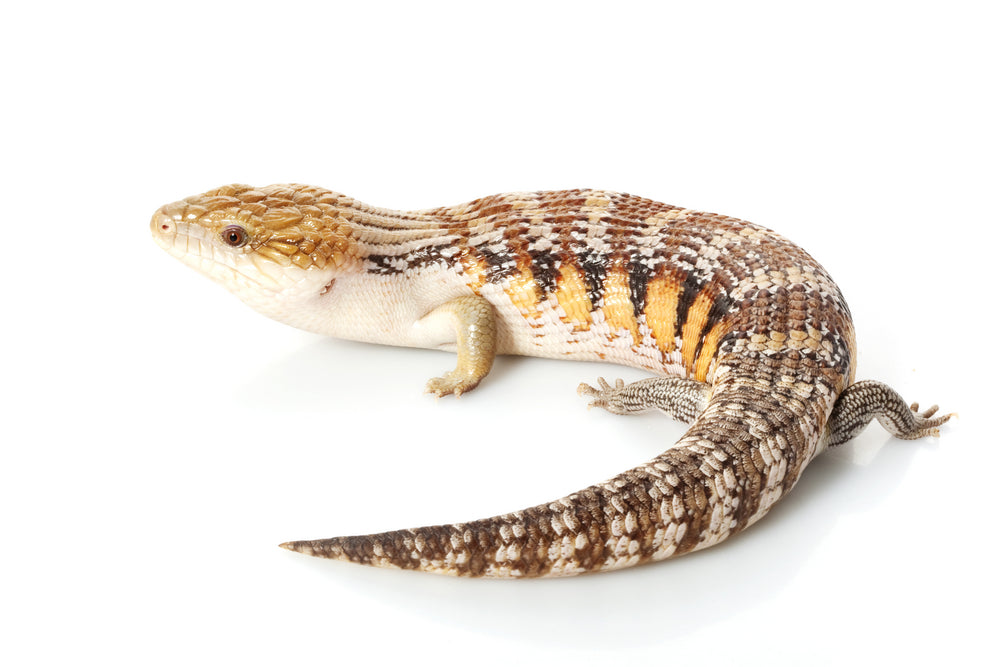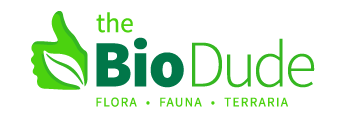Blue Tongue Skink Care Guide

Blue Tongue Skink (Tiliqua spp.)
Difficulty: Intermediate
Caresheet courtesy of Mariah Healy of www.ReptiFiles.com
Blue tongue skinks are a group of diurnal, terrestrial lizards found throughout Australia and parts of Indonesia. They can grow up to 24” long, and have an average lifespan of 15-20 years, although with good care, they can live past the age of 30.
Blue tongue skinks have thick, sausage-like bodies, short but strong limbs, and triangular heads. But their most distinctive feature is their namesake — a blue tongue. Most members of Tiliqua have blue or bluish tongues. Although popular speculation places this unique trait as a defense mechanism against predators, it may also play a role in communication with other blue tongue skinks.
There are 12 known species of Tiliqua, but due to strict export restrictions on Australian animals, only 5 of them are commonly kept in the US:
-
Northern blue tongue skink (Tiliqua scincoides intermedia)
-
Classic Indonesian blue tongue skink (Tiliqua gigas gigas)
-
Halmahera blue tongue skink (Tiliqua gigas gigas halmahera)
-
Merauke blue tongue skink (Tiliqua gigas evanescens)
-
Irian Jaya blue tongue skink (Tiliqua ssp.)
Different types of blue tongue skinks have slightly different care requirements. For visuals on what each type looks like, visit ReptiFiles.
What You Will Need for a Pet Blue Tongue Skink:
-
4’x2’x2’ reptile enclosure
-
8-10” dome heat lamp with a ceramic socket
-
Dual dome lamp fixture
-
plug-in lamp dimmer, x2
-
temperature gun
-
24” T5 HO fluorescent light fixture
-
light timer
-
pressurized spray bottle
-
substrate:
-
Australians: Terra Firma Bioactive Kit 4' x 2' x 2' PVC Kage
-
Indonesians: Terra Fauna Bioactive Kit 36 x 18 x 18/24, x2
-
-
clean up crew (CUC)
-
large flat basking rock
-
hide (cave)
-
decorations (plants, logs, branches, etc.)
-
soft-tipped feeding tweezers
Terrarium Size
Blue tongue skinks are relatively large lizards that grow quickly, so the minimum recommended enclosure size even for a baby is going to be 4’x2’x2’, or 8 sq ft of floor space. Blue tongue skinks are quite active, so if you can afford/fit a larger enclosure, it’s strongly advised to do so. Bigger is always better!
For maximum convenience, get an enclosure that opens from the front rather than from the top. PVC is generally the best material for a blue tongue skink enclosure, as it’s waterproof and lightweight, but glass or well-sealed wood are also options.
Do not house more than 1 blue tongue skink per enclosure. Housing blue tongue skinks together will likely stress them out, and risks them fighting and getting severely injured.
Lighting
Blue tongue skinks are diurnal, which means that they are active during the day. And as reptiles, they need UVB lighting as part of their environment to encourage health and wellness. Reptiles use UVB light to create the vitamin D that their body needs, as well as to strengthen their immune system, and stimulate production of endorphins. UVB even helps keep the enclosure free of pathogens.
The Zoo Med ReptiSun 10.0 T5 HO and Arcadia Desert 12% are high-quality fluorescent bulbs that provides the right amount of UVB for blue tongue skinks in a 4’x2’x2’ enclosure. These bulbs must be replaced once a year to remain effective. For best results, install the bulb in a reflective fixture like the Zoo Med Reptisun T5 HO Terrarium Hood or The Bio Dude Solar Grow light fixture.
The UVB bulb and fixture should span 1/2 of the enclosure’s length, and should be placed on the same side as the heat lamp, because heat and UVB work together.
If you are setting up a bioactive enclosure, you will also need a full-spectrum fluorescent or LED grow light for the plants. This is also beneficial for the skink, so it’s a win-win!
Heating
Unlike humans, blue tongue skinks and other reptiles are cold-blooded, which means that they need external heat for their bodies to work properly. A diurnal (day active) reptiles, blue tongue skinks use heat most effectively from an overhead heat source that mimics the sun. And because they’re cold-blooded, they need a gradient of temperatures inside their enclosure so they can warm up and cool down as needed:
-
Basking surface:
-
Northerns — 105-115°F
-
Others — 100-105°F
-
-
Cool side: 70-80°F
-
Nighttime: No lower than 65°F
To create your basking area, use a high-wattage halogen flood bulb inside of a dome heat lamp with a ceramic. You can find the bulbs you need at the hardware store or pet store. For an average 48″ x 24″ x 24″ enclosure, 100-150w should achieve the temperatures you need. If you find that gets a bit too hot, use a plug-in lamp dimmer to dial down the heat. To create the best basking area possible, place a large, flat stone (large enough for the skink’s whole body) under the basking lamp for the skink to bask on.
How do you make sure you’re doing it right? Don’t get a cheap gauge-type stick-on thermometer — these aren’t very accurate. Instead, use an infrared temperature gun like the Etekcity 774 to measure surface temperature. Using a digital probe thermometer like the Bio Dude Digital Thermometer / Hygrometer is also a good way to track your basking temperature when the probe is placed on the basking surface.
Humidity
All life on Earth depends on water. Animals can get it either by drinking it, eating food that contains water, or by breathing humid air. Reptiles need specific levels of humidity in their environment for best health, and the requirements for blue tongue skinks are as follows:
-
Northern blue tongue skink — 40-60%
-
Classic Indonesian blue tongue skink — 60-80%
-
Halmahera blue tongue skink — 80-100%
-
Merauke blue tongue skink — 60-80%
-
Irian Jaya blue tongue skink — 60-80%
Simply add water to the enclosure via spray bottle to increase humidity. Bioactive substrates are excellent at maintaining humidity compared to other substrate options.
Humidity will naturally be higher on the cool side of the enclosure than on the warm side, so use a Bio Dude Digital Thermometer / Hygrometer with the probe placed on the cool side to track the humidity levels in your skink’s habitat.
Substrate
“Substrate” is another word for bedding. Blue tongue skinks are burrowing lizards, so they require 4-6 inches of deep, soft, loose substrate. But which kind of substrate you need depends on your type of skink. Australian species need dry substrates, and Indonesian species need humid substrates.
The Bio Dude’s Terra Firma Bioactive Kit is excellent for creating a bioactive substrate for Northern blue tongue skinks, and The Bio Dude’s Terra Fauna Bioactive Kit is excellent for creating a bioactive substrate for Indonesian blue tongue skinks.
Bioactive substrates need a clean-up crew (CUC) of beneficial bugs to work properly. At very least you will need relatively large cultures of tropical springtails and isopods such as powder blues, powder oranges, or dwarf purples.
For best results, let your bioactive substrate and any live plants get established for about a month before adding your blue tongue skink.
Feeding Your Blue Tongue Skink
Blue tongue skinks are omnivores, which means that they need to eat both plant and animal matter to be healthy. And like humans, skinks’ nutritional needs change as they grow.
· Animals —
o 70-80% for <2 years old
o 50-60% for >2 years old
· Plants —
o 20-30% for <2 years old
o 40-50% for >2 years old
How much should a blue tongue skink eat?
-
Feed babies (up to 3 months) daily.
-
Feed juveniles (3-8 months) 3 times weekly.
-
Feed adults (8+ months) 1-2 times weekly.
Portion size should be about the same size as the skink’s skull.
The key to success with blue tongue skinks (and most reptiles, for that matter) is to feed them as large a variety of foods as possible. The below options are just a small sample list. For a more comprehensive list of feeding options, and which foods to avoid, visit ReptiFiles.
Animals
Meat-
eggs
-
small rodents, live or pre-killed
-
high quality dog food
-
high quality cat food
Insects
-
crickets
-
roaches
-
snails (not wild)
-
silkworms
-
earthworms
Feeder insects should be no bigger than the space between your skink’s eyes. ALL FEEDER INSECTS SHOULD BE COATED IN CALCIUM SUPPLEMENT BEFORE FEEDING. For best results, give your dragon a variety of bugs for best nutrition.
Plants-
collard greens
-
dandelion greens
-
carrot greens
-
turnip greens
-
shredded squash
-
bell pepper
-
shredded carrot
Fruits should be used as treats only due to their high sugar content.
Calcium & Vitamins
To ensure that your skink is getting all the vitamins and minerals they need, you need a calcium powder and a multivitamin powder. Take care not to use these too often; too much vitamins can be just as deadly as too little. We recommend Miner-ALL Outdoor (no D3) dusted on all insects and Exo Terra Reptile Multivitamin sprinkled on food once a month.
Water
Aside from humid air in their environment, blue tongue skinks also need a water dish so they can drink water as needed. Choose a bowl that is large enough for the skink to soak in as desired, but shallow enough to prevent drowning.
Handling Tips
When you first bring your blue tongue skink home, resist the temptation to immediately start playing with it. You’re huge compared to a blue tongue skink, and s/he needs time to figure out that you’re not going to eat them. Let your new pet settle in for at least 2 weeks before you start handling.
Once your skink has established confidence in his/her new home, you can introduce yourself. Let them get comfortable with your scent by placing an old, used shirt in the terrarium. Let your hand rest in the terrarium and allow the skink to familiarize itself with your hand.
After your skink has stopped running away from your hand and seems calm in your presence, you can start to handle them. But just because you have reached this step does not mean your pet trusts you. Trust and friendship (as far as it goes for lizards) takes time and daily handling.
Handling Techniques
-
Support the whole body.
-
Use slow movements.
-
Do not grab or forcibly restrain unless absolutely necessary.
-
If they are shedding, leave them alone and don’t pull on loose skin.
Care information courtesy of ReptiFiles. Visit ReptiFiles.com for further information on blue tongue skink care.
Updated and fact checked July 22nd 2022
- Tags: blue tongue skink
- Josh Halter








